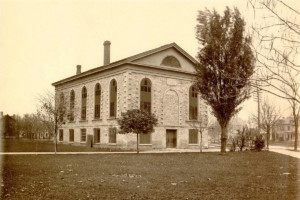 BEATTY CHURCH
BEATTY CHURCH
SE corner Washington & Jackson
Beatty Church, ca. 1890. Image courtesy of Sandusky Library Archives Research Center
A person looking in a south easterly direction from the northeast corner of Jackson and West Washington St. anytime during the latter half of the 19th century would have seen the old Beatty Church which stood just northwest of the courthouse.
On June 23, 1835 S.G. Wilson arrived in Sandusky and arranged to deliver a course of lectures on the subject of slavery to be given in the Methodist Meeting House. Word of his lectures soon spread and the next day Col. John N. Sloan wrote and circulated a petition to the trustees of the Methodist Meeting House implying that Wilson favored “amalgamation of the black and white population” and asking them to “close your church door against men who wish to inculcate doctrines and principles fraught with such evil wicked and corrupt consequences as we deem the doctrines of abolitionism to be surcharged with.” Thirty nine individuals signed the petition, threats were made, and Wilson was denied access to the Methodist Meeting House.
Sandusky’s mayor, John Beatty, was determined that the lectures should be given and declared that “this was a free country and while he had any of the blood of ’76, Sandusky should not be governed by the mobocracy.” The Methodist Trustees soon backed down. Wilson was allowed to give two lectures, but when he arrived for his final lecture, he was barred from the Meeting House.
Mayor Beatty promptly withdrew his membership in the church and formed a new Methodist Church known as the Beatty Church which was an attractive stone building located at the west end of Washington Park along Jackson Street facing West Washington Street. After Beatty’s death, most of the membership of the Beatty Church returned to the parent church.
During the Cholera Epidemic of 1849 the City of Sandusky seized the Beatty Church for use as a cholera hospital. In 1855 the building was purchased by the Baptist community who then sold it to the German Lutherans in 1862. The Beatty Church was demolished in 1899 when the Lutherans moved to their new facility on Columbus Avenue.
John Beatty’s principled stand in favor of free speech indicates that he was a man of great character. It is ironic that his adversary, Col. John N. Sloane, was the father of Rush R. Sloane who was to become Sandusky’s leading abolitionist and future mayor. READ MORE
